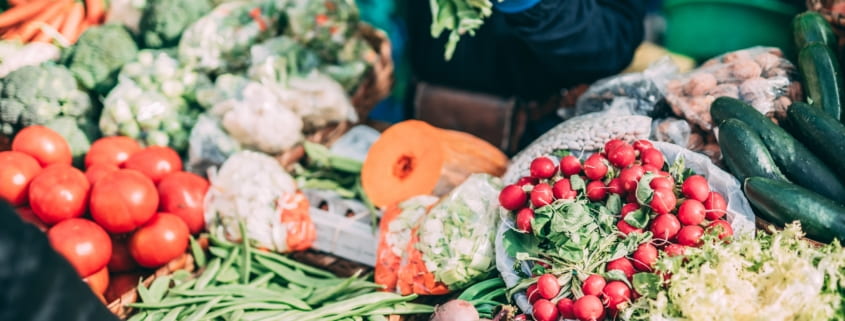Singaporean Farmers’ Markets: Building a culture of “buying local”
By Bryan Teo Jun Kai (’24) and Lee Shao Ming (’24).
Farmers’ Markets — sprawling spaces with rows of stalls filled with painstakingly grown produce — serve as a dedicated space for local producers to connect with the community and sell their home-grown produce. However, something special grows amidst the bargaining: an appreciation of the work farmers put into their produce, and a unique culture of “buying local”.
In Singapore, Farmers’ Markets are not yet our preferred shopping option. Most Singaporeans presently get their groceries from giant supermarket chains and wet markets, neither of which exclusively cater to locally-grown produce. Consequently, there remains a lack of awareness of and demand for locally-grown produce among Singaporean consumers.
The Farmers’ Markets that do exist, such as the Loewen’s Farmers’ Market near Dempsey [1], are located far away from denser residential areas and only accessible by private transportation. These are not places most Singaporeans will go to, which means that farmers there suffer from less demand for their home-grown food. A “buy local” culture has yet to be incorporated into our lives.
This poses a challenge to the Singapore Food Agency’s (SFA) 30 by 30 goal [2], which aims for Singapore to produce 30% of our food needs by 2030. With 90% of Singapore’s food dependent on imports, externalities can easily disrupt essential food supply chains, throwing us into immediate instability. Worries around food security, including early panic buying [3] caused by news of Covid-19 lockdowns in early-2020, are never too far away from us.
In light of these concerns, the SFA has poured significant resources into enhancing local production of food and maintaining affordable prices for consumers [4]. On the supply side, we appear to be making significant progress.
However, we must not forget about the demand side of things. Locally-produced food needs strong and stable demand from Singaporean consumers to be a mainstay. To cultivate this long-term demand, the current mechanism through which local farmers sell their produce is insufficient. Because of a lack of accessibility to and awareness about local produce, local farmers struggle to see sustainable demand for their goods. If this persists, the resources and hard work invested into them may end up like that of a single hand trying to clap: for naught.
We need to bring our Farmers’ Markets to more central locations, so that they become more accessible to a wider consumer base in Singapore, where they can then play a strong role in developing demand for local produce. We suggest that Farmers’ Markets instead leverage upon the convenience of existing supermarket chains and wet markets, while incorporating the benefits of traditional Farmers’ Markets: home-grown produce and a connection between farmers and consumers. This would be a hybridised version of a Farmers’ Market, uniquely adapted to our urban setting.
This way, we maintain the convenience that Singaporeans are used to, but add the benefits that Farmers’ Markets bring to their communities. A 2019 study, for example, concluded that Farmers’ Markets allow producers to be in direct contact with consumers, adding to the number of socially and environmentally sustainable food systems [5]. Another earlier article [6] shows how Farmers’ Markets in Vancouver Island promote local food security, buffering its residents against disruptions of long term food supply. All these are in line with Singapore’s own food sustainability goals.
Dedicated spaces for local farmers in supermarkets and wet markets
First, to expose Singaporeans to local produce, the SFA should collaborate with popular supermarkets and wet markets to dedicate a section of space just for local produce. This would enable local farmers and their produce to connect to Singaporeans directly without radically altering the way people already get their food. More importantly, these dedicated spaces would familiarise local consumers with local produce and brands, and emphasise the origins of these produce more prominently than current miniscule labels do [7]. This would help cultivate an instinct for buying local, and encourage customers to pay attention to the origin of their produce over time.
Shoppers should not be faced with faceless shelves of local produce. Local farmers themselves can be present in the supermarkets and wet markets, building ties with their customers. Such socialisation would allow farmers to build brand awareness and customer loyalty to their produce, securing a critical mass of local demand over time.
Bringing Farmers’ Markets into the residential spaces
Furthermore, another way to introduce Farmers’ Markets into Singaporean culture would be to situate the markets amid public housing. The issue of under-utilised spaces such as car parks and void decks have been recognised by the government, who have called on the public to provide creative ways to utilise the space for community development [8].
These spaces are well-suited for hosting our version of Farmers’ Markets. With inter-government agency collaborations between the Housing and Development Board (HDB) and the SFA, we could have farmers’ markets featuring local farmers selling their produce and interacting with consumers in the void decks and other open spaces near the HDB blocks.
Here, it is worth considering the theory of third places. The theory of third places is defined by sociologist Ray Oldenburg in his book The Great Good Place as “anchors of community life (which) facilitate and foster broader, more creative interaction” [9]. Put simply, it is a welcoming ground for social interactions.
The incorporation of Farmers’ Markets into the under-utilised public spaces would achieve this additional goal of carving out third places. Due to the proximity of these places to public housing, the practical need for people to purchase produce, and the novelty of our proposed solution, we expect that these under-utilised places will transform into bustling hotspots by facilitating social interactions. Hence, a culture of buying local produce via Farmers’ Markets can be successfully cultivated across all these public spaces.
As a small nation, Singapore continuously faces the challenges of space and manpower. Our proposed solutions, which uses existing infrastructure to carve out dedicated sections in supermarkets and wet markets for local produce, as well as situating Farmers’ Markets in under-utilised public housing spaces, address these challenges directly and conveniently.
With their long-term benefit of enhancing local food security, supporting local producers, and bringing our communities closer together, it is clear that the development of Farmers’ Markets in Singapore is the way forward.
Endnotes
- “Farmer’s Markets At Loewen Gardens.” The New Age Parents. The New Age Parents, 2018. https://thenewageparents.com/farmers-markets-at-loewen-gardens/.
- Ai-Lien, Chang. “Singapore Sets 30% Goal for Home-Grown Food by 2030.” The Straits Times, March 8, 2019. https://www.straitstimes.com/singapore/spore-sets-30-goal-for-home-grown-food-by-2030.
- “Panic Buying Hits Singapore after Virus Alert Raised.” businesstimes.com.sg, February 8, 2020. https://www.businesstimes.com.sg/government-economy/panic-buying-hits-singapore-after-virus-alert-raised.
- Singapore Food Agency. “Our Singapore Food Story.” SFA, 2020. https://www.sfa.gov.sg/food-farming/sgfoodstory/supporting-local-produce.
- Figueroa-Rodríguez, Katia, María Álvarez-Ávila, Fabiola Hernández Castillo, Rita Schwentesius Rindermann, and Benjamín Figueroa-Sandoval. “Farmers’ Market Actors, Dynamics, and Attributes: A Bibliometric Study.” Sustainability 11, no. 3 (2019): 745. https://doi.org/10.3390/su11030745.
- Alexandra, Link, and Chris, Link “Farmers’ Markets and Local Food Systems.” CRC Research, 2007. Accessed July 25, 2021. https://www.crcresearch.org/crc-case-studies/farmers-markets-and-local-food-systems.
- Singapore Food Agency. “Our Singapore Food Story.” SFA, 2020. https://www.sfa.gov.sg/food-farming/sgfoodstory/supporting-local-produce.
- Teo, Gwyneth. “Singapore Urban Design Festival Organisers Look at under-Utilised Spaces for Events: Video.” Channel NewsAsia, November 7, 2020. https://www.channelnewsasia.com/news/singapore/singapore-urban-design-festival-organisers-look-at-under-11353164.
- Oldenburg, Ray. The Great Good Place: cafés, Coffee Shops, Bookstores, Bars, Hair Salons, and Other Hangouts at the Heart of a Community. Cambridge, MA: Da Capo Press, 1999.
- Lim, Natalie. “5 Farmers’ Markets In Singapore To Switch Up Your Otherwise Mundane Grocery Runs.” TheSmartLocal, January 9, 2020. https://thesmartlocal.com/read/farmers-markets/.
- Dodds, Rachel, Mark Holmes, Vichukan Arunsopha, Nicole Chin, Trang Le, Samantha Maung, and Mimi Shum. “Consumer Choice and Farmers’ Markets.” Journal of Agricultural and Environmental Ethics 27, no. 3 (2013): 397–416. https://doi.org/10.1007/s10806-013-9469-4.
Image credit: Unsplash




Leave a Reply
Want to join the discussion?Feel free to contribute!